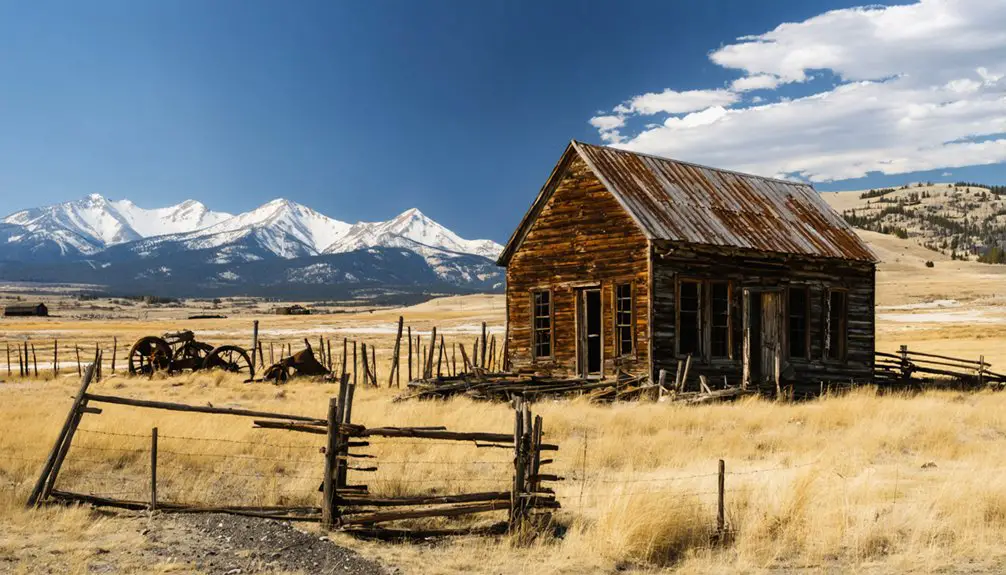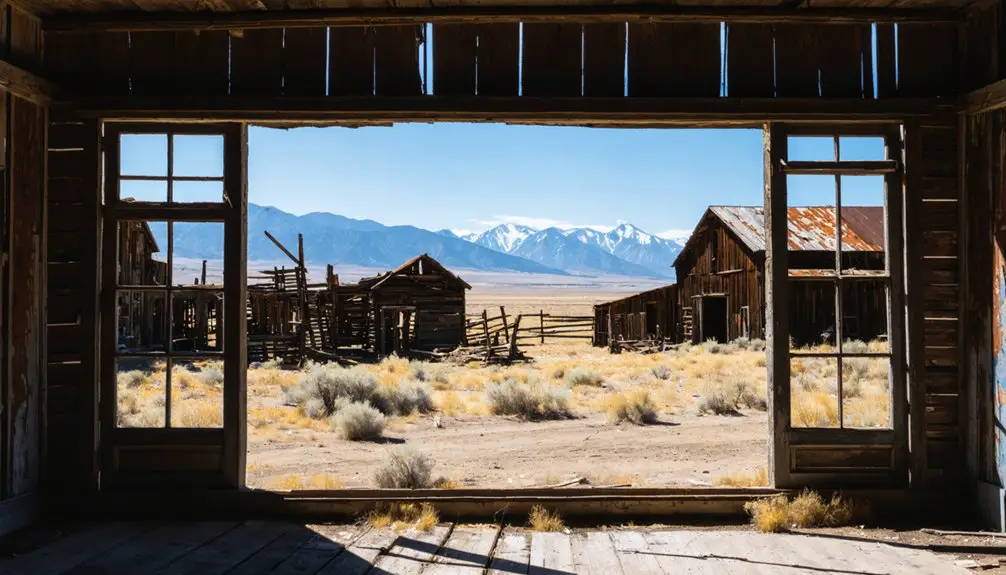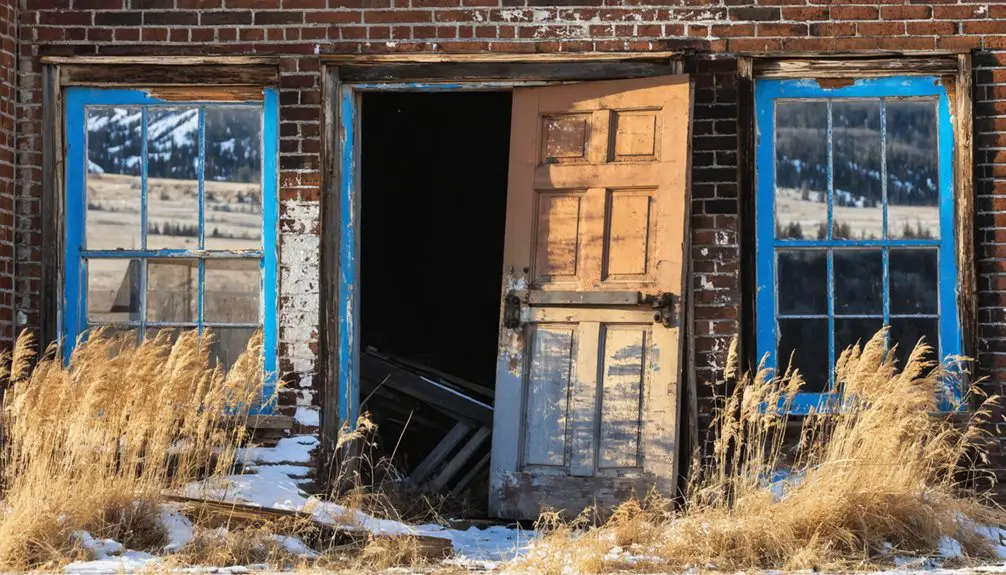You’ll find Southern Cross nestled at 7,000 feet overlooking Georgetown Lake, where gold’s discovery in 1866 sparked eight decades of mining history. This Montana ghost town once housed 500 residents, primarily Finnish and Swedish miners, who built a bustling community with saloons, boarding houses, and traditional saunas. The site generated $5 million in precious metals before its decline, and today its remaining structures tell compelling stories of Montana’s mining heritage.
Key Takeaways
- Southern Cross was a thriving gold mining town established in 1866, reaching a peak population of 500 residents, primarily Finnish and Swedish miners.
- Located at 7,000 feet elevation near Georgetown Lake, the site produced $5 million in precious metals including gold, silver, and copper.
- The ghost town features original mining structures, boarding houses, and cultural elements like Finnish saunas that reflect its immigrant heritage.
- Mining operations lasted eight decades, with the Anaconda Copper Mining Company’s 1910 acquisition providing crucial railroad access.
- While some original buildings still stand, the site lacks formal preservation efforts and faces challenges from fragmented ownership and minimal maintenance.
The Discovery of Gold and Early Settlement

While Montana’s gold rushes began in earnest during the 1850s, Southern Cross’s story didn’t start until 1866, when prospectors discovered gold deposits on a mountainside overlooking Georgetown Lake.
Early miners faced the same challenges as those at Fort Benton, who had to navigate treacherous river routes to reach Montana’s promising goldfields.
You’ll find that this discovery followed the pattern of earlier Montana gold strikes, where small groups of prospectors searched remote areas for placer gold using basic tools like pans and shovels. This was similar to the discovery in Confederate Gulch, where grain of wheat sized gold was found.
Under Salton Cameron’s ownership in the 1870s, the settlement transformed from a simple prospecting site into a bustling mining operation.
Cameron initially shipped ore to East Helena for processing before establishing a stamp mill in 1884.
Though this first mill failed, it marked the beginning of Southern Cross’s development into a proper mining community that would eventually support 500 residents.
Life in a Montana Mining Town
You’d find the daily rhythms of Southern Cross miners strictly governed by shift whistles, with workers rotating through grueling schedules that affected their entire families’ routines.
As miners descended underground, they’d build not just tunnels but also strong bonds, relying on each other for safety and companionship during their long hours below the surface. In the dim tunnels, miners navigated by the glow of their candle-lit helmet lights.
The dangers and demands of mining life shaped the broader community, where families adapted by creating support networks and local businesses emerged to serve the miners’ basic needs. Local saloons and barbers catered to miners seeking relief after their exhausting shifts.
Daily Mining Life
Life in a Montana mining town during the gold rush era revolved around backbreaking work and harsh conditions. You’d spend long hours wielding heavy tools, battling extreme weather, and facing constant mining hardships like frostbite and hazardous terrain.
Labor challenges weren’t limited to the mines – you’d need to test ore samples through assaying, using techniques like panning and chemical treatments to determine gold content. Most miners spent their meager earnings on basic supplies. The local barber shops served as important social gathering spots where miners could get cleaned up and exchange news.
Your daily existence meant confronting poor sanitation, cramped wooden shelters, and minimal creature comforts. You’d gather water, chop firewood, and maintain basic supplies just to survive.
Claims disputes and lawlessness added to the volatile environment, while the mix of rough characters and transient workers created an unstable social atmosphere.
During off-hours, you’d find escape in saloons and gambling halls, where drinking and fighting were common diversions.
Building Community Underground
Despite the harsh realities of mining life, Southern Cross developed into a thriving community of 500 residents during its peak in the early 20th century.
You’d find strong community bonds forming both above and below ground, particularly among Finnish and Swedish immigrants who brought their cultural heritage with them. The town’s shared spaces became essential gathering points where miners and their families connected.
- The popular community dance hall hosted events that brought together residents from diverse backgrounds.
- Finnish saunas served as both practical facilities and social hubs, maintaining immigrant heritage.
- Boarding houses created close-knit living arrangements where miners shared daily life and formed lasting friendships.
These gathering spaces helped transform what could have been just a work camp into a real community where families put down roots and stayed, even as mining operations declined.
Mining Operations and Economic Growth
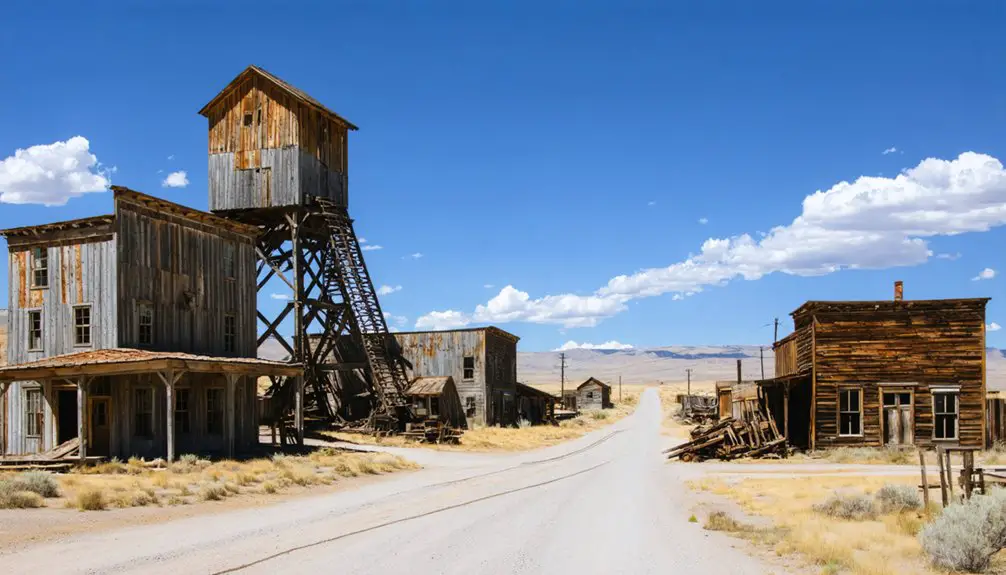
The discovery of gold in Southern Cross during 1866 launched eight decades of mining operations that would shape Montana’s economic landscape.
You’ll find that production reached 404,000 metric tons of ore by 1968, with economic fluctuations driving the mine’s development through different ownership phases.
When Salton Cameron first developed the property in the 1870s, ore processing meant shipping to East Helena, but mining sustainability improved dramatically after 1906 with wet-crushing mills.
The Anaconda Copper Mining Company’s 1910 acquisition brought vital railroad access, streamlining transportation and boosting production efficiency.
While gold and silver were the primary targets, you’ll see the mine’s $5 million output included copper, arsenic, and bismuth, contributing considerably to Deer Lodge County’s economy through the 1940s.
The Golden Years: Peak Population and Development
You’ll find Southern Cross at its peak bustling with around 500 residents, primarily Finnish and Swedish immigrant miners and their families who shaped the town’s distinctive Nordic character.
The town’s infrastructure grew to meet the community’s needs, featuring multiple boarding houses, a post office, school, stores, and recreational facilities including a dance hall and several traditional saunas.
During the golden years of 1909-1930, you’d witness a thriving community supported by the Sundown Limited rail service, which connected Southern Cross to Butte and facilitated the movement of people and goods across the 45-mile stretch.
Community Life at Peak
During Southern Cross’s golden years from 1909 to 1930, approximately 500 residents created a vibrant multicultural community shaped noticeably by Finnish and Swedish immigrants.
You’d find the town’s social life centered around community gatherings in the dance hall and cultural celebrations that reflected the strong Scandinavian influence. The post office and local stores served as hubs where miners and their families would connect, while boarding houses fostered close relationships among workers.
- Scandinavian-style saunas provided both practical and social spaces, offering relaxation after long mining shifts.
- The school and community hall formed the foundation for civic activities and children’s education.
- Local stores and boarding houses created informal meeting spots where residents shared daily life and maintained strong community bonds.
Mining Town Infrastructure Growth
As Southern Cross evolved from a primitive mining camp into a bustling town between 1909 and 1930, substantial infrastructure development transformed the mountainous settlement at 7,000 feet elevation.
You’d find essential community support structures including boarding houses, bunkhouses, a dance hall, post office, school, and traditional Finnish saunas serving the mainly Scandinavian population of 500 residents.
The Anaconda Copper Mining Company‘s 1910 acquisition marked a pivotal advancement in the town’s development. They extended the railroad from Brown’s siding to the mine, revolutionizing ore transport capabilities.
The installation of a wet-crushing mill after 1906 enhanced ore processing, replacing the inefficient 1884 stamp mill. These improvements, along with miners’ housing and supervisors’ residences, created a self-sustaining community that generated approximately $5 million in precious metals.
Architecture and Building Heritage
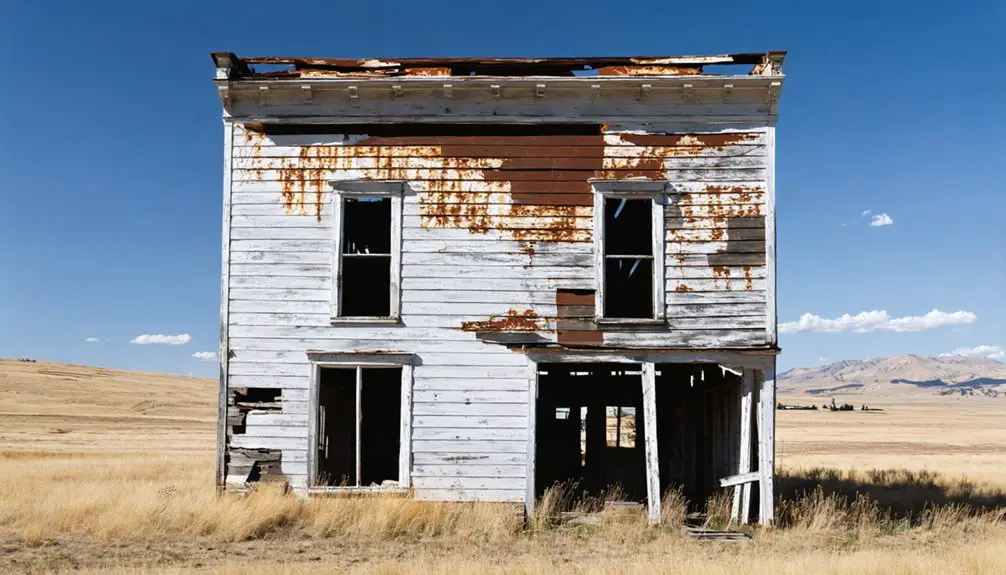
The rugged architecture of Southern Cross reflects its 1860s gold rush origins and the practical needs of a Montana mining community.
You’ll find locally sourced timber and stone buildings showcasing vernacular construction methods that have withstood decades of harsh mountain weather. The architectural significance of these structures lies in their authentic representation of mining-era craftsmanship and Finnish-Swedish cultural influences.
- Original stamp mills, wet-crushing facilities, and hoist buildings demonstrate industrial mining heritage
- Community structures like boarding houses and Finnish saunas reflect immigrant miners’ cultural identity
- Historic preservation efforts by residents, rather than corporations, have maintained the authentic character of buildings dating to the 1870s
The weathered yet enduring buildings tell a story of freedom-seeking miners who built a self-reliant mountain community that peaked at 500 residents.
St. Timothy Memorial Chapel: A Modern Landmark
You’ll find St. Timothy Memorial Chapel‘s striking geometric angles and modern rustic design elements boldly standing out against the rugged Montana landscape, serving as a tribute to 1960s modernist architecture.
The chapel’s harmonious blend of native stone and timber creates a unique bridge between contemporary design and the natural environment, distinguishing it from typical regional structures of its era.
While Southern Cross may be a ghost town, the chapel remains culturally essential today, hosting summer concerts and community gatherings that bring life and music to this historic mining site.
Modern Design Elements
Standing as a showcase to 1960s Montana modernism, St. Timothy Memorial Chapel showcases architectural innovation through its striking blend of natural materials and contemporary design.
You’ll find native stone and timber masterfully integrated with geometric angles, creating modern aesthetics that both complement and contrast the rugged mountain setting.
- Floor-to-ceiling windows provide sweeping views of Georgetown Lake and the Pintlar Wilderness, connecting interior spaces with the dramatic landscape.
- A prominent Celtic cross emerges from the hillside design, serving as both a spiritual symbol and architectural focal point.
- The chapel’s modern Rustic style maintains clean lines while incorporating local materials, demonstrating how 1960s design principles could harmonize with Montana’s natural beauty.
Cultural Impact Today
Since its dedication in 1965, St. Timothy Memorial Chapel has evolved into an essential cultural cornerstone of the Georgetown Lake area.
You’ll find this modern landmark hosting diverse cultural events throughout the summer months, from chamber music performances to jazz concerts, all set against the backdrop of the majestic Pintlar Mountains.
The chapel’s impact extends beyond religious services, fostering community engagement through weddings, retreats, and small group gatherings.
You can experience its unique blend of spiritual and cultural significance from mid-May through September, when the venue welcomes visitors from across the region.
As one of the few preserved structures in Southern Cross ghost town, the chapel serves as a bridge between the area’s mining heritage and contemporary life, drawing tourists interested in both historical architecture and modern cultural programming.
Natural Setting and Geographic Features
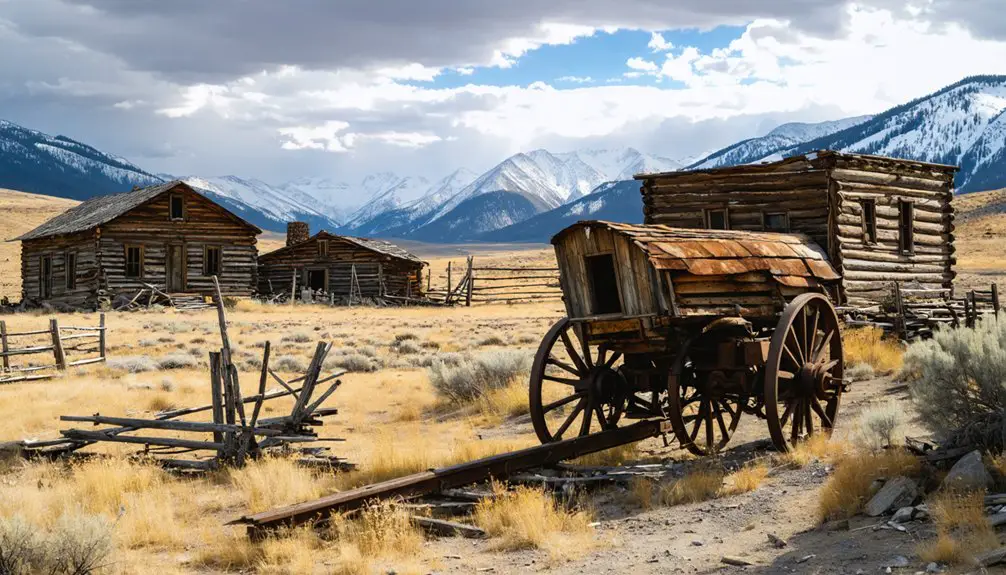
Perched at 7,000 feet above sea level in Montana’s Deer Lodge County, Southern Cross commands spectacular views of Georgetown Lake and the surrounding wilderness from its mountainside location.
You’ll find a natural landscape shaped by historic gold mining dating back to 1866, with steep slopes and rocky outcrops supporting remnants of mining structures. The area’s ecological diversity thrives in the mixed coniferous forests that have reclaimed the terrain.
- Explore the rugged terrain nestled between the Anaconda Pintlar Wilderness peaks and Flint Creek range
- Discover pristine mountain waters flowing from seasonal snowmelt into Georgetown Lake
- Experience the untamed environment where pine, fir, and spruce trees shelter native Rocky Mountain wildlife
Cultural Legacy and Community Traditions
Beyond the rugged terrain and natural beauty, Southern Cross harbored a rich cultural tapestry woven by its diverse community of Finnish and Swedish miners.
You’ll find evidence of cultural resilience in the town’s preserved structures, including boarding houses, stores, and the iconic St. Timothy Memorial Chapel, which still hosts chamber music concerts today.
The community’s identity thrived through shared traditions like communal saunas and gatherings at the local dance hall.
Even as the mining era faded, residents demonstrated their dedication by maintaining historic buildings and paying land lease fees to preserve their heritage.
Though many faced eventual eviction, their efforts to protect Southern Cross’s legacy live on through preserved artifacts, documented histories, and the ethical guidelines that now protect this remarkable ghost town’s cultural remains.
Preservation Efforts and Current Status
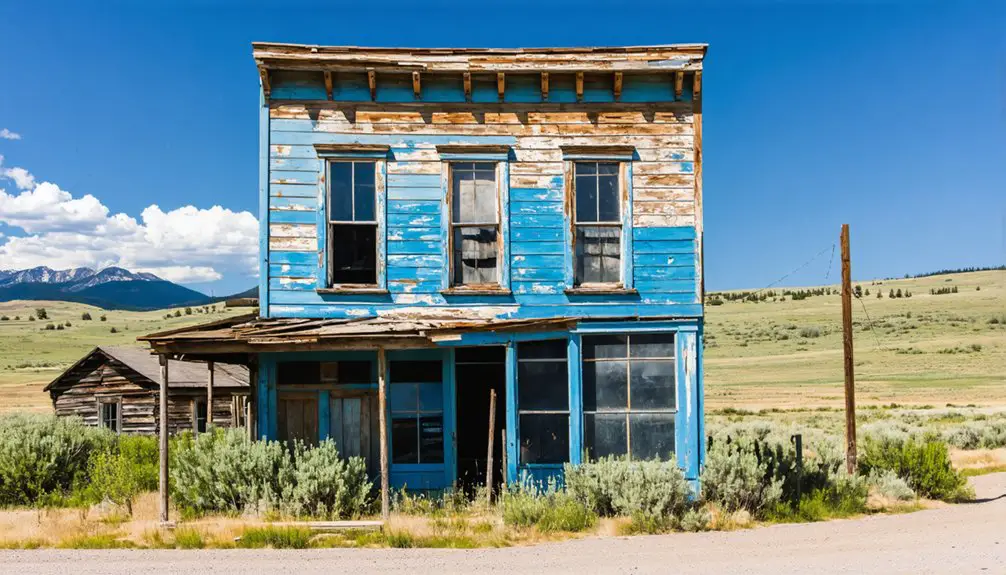
While other Montana ghost towns enjoy robust preservation programs, Southern Cross faces ongoing challenges in maintaining its historical structures.
You’ll find several original mining buildings and dwellings still standing, though their condition varies considerably. Without formal state protection or an organized preservation society, the site remains vulnerable to redevelopment pressures and natural decay. In contrast to places like Bureau of Land Management protected sites, Southern Cross has no caretakers monitoring its condition.
Southern Cross’s historic structures stand precariously, lacking official protection and facing threats from both development and time’s relentless march.
- Seasonal occupants provide limited maintenance to some structures, but there’s no thorough preservation plan
- Unlike Bannack or Garnet Ghost Towns, Southern Cross lacks dedicated visitor facilities or interpretive programs
- Community involvement remains minimal, with no active volunteer groups focusing on site protection
The town’s preservation challenges are complicated by fragmented ownership and limited funding, leaving its historical artifacts and remaining structures at risk without systematic intervention.
Historical Impact on Montana’s Mining Legacy
As one of Montana’s most illustrative mining settlements, Southern Cross played a pivotal role in shaping the state’s mineral extraction heritage from 1866 to 1940.
You’ll find evidence of mining technology evolution through its stamp mill construction in 1884 and the introduction of wet-crushing processes in 1906, marking significant advances in ore processing capabilities.
The camp’s influence extended beyond technology to its immigrant labor force, primarily Finnish and Swedish workers who brought their cultural traditions to Montana’s mining landscape.
Their contribution of $5 million in precious metals production, coupled with Anaconda Copper Mining Company‘s involvement after 1910, strengthened the region’s economic foundation.
Today, Southern Cross stands as a tribute to Montana’s mining era, preserving the physical remnants of late 19th and early 20th-century mining operations.
Frequently Asked Questions
Are There Any Paranormal Activities Reported in Southern Cross?
You won’t find documented ghost sightings or verified paranormal activities in Southern Cross. Unlike other Montana ghost towns with established local legends, there aren’t any confirmed supernatural reports from this location.
Can Visitors Stay Overnight in Any of the Remaining Buildings?
You can’t stay overnight in Southern Cross buildings due to preservation rules and safety concerns. Instead, you’ll find proper overnight accommodations in nearby Virginia City’s historic inns and cabins.
What Happened to the Original Mining Equipment and Machinery?
After millions of dollars in mining history vanished, you won’t find much original equipment today. The 1884 stamp mill was scrapped, while later machinery was abandoned, dismantled, or removed by 1940.
Is Gold Still Being Found in the Area Today?
You’ll find gold prospecting still occurs in the area, though modern mining regulations limit large-scale operations. While companies actively explore nearby claims, most current discoveries are smaller deposits requiring permits.
How Many Original Families or Descendants Still Live There?
Like a fading photo, there’s not a single original family left today. Current residents number only 4-5 people, none with documented family history linking them to Southern Cross’s early settlers.
References
- https://montanahistoriclandscape.com/2013/10/06/modernism-in-a-montana-ghost-town-st-timothys-at-southern-cross/
- https://www.mtghosttowns.com/southern-cross
- https://www.ghosttowns.com/states/mt/southerncross.html
- https://www.mtmemory.org/nodes/view/128282
- https://ghosttownfinder.com/towns/southern-cross-montana
- https://www.clengpeerson.no/gold-discovery-established-meagher/
- https://mhs.mt.gov/education/textbook/chapter6/Chapter6.pdf
- https://discoveringmontana.com/history-of-the-gold-rush/
- https://montana-gold.blogspot.com/2010/02/gold-deposits-of-montana.html
- https://montanakids.com/agriculture_and_business/mining/Early_days_of_Mining.htm
